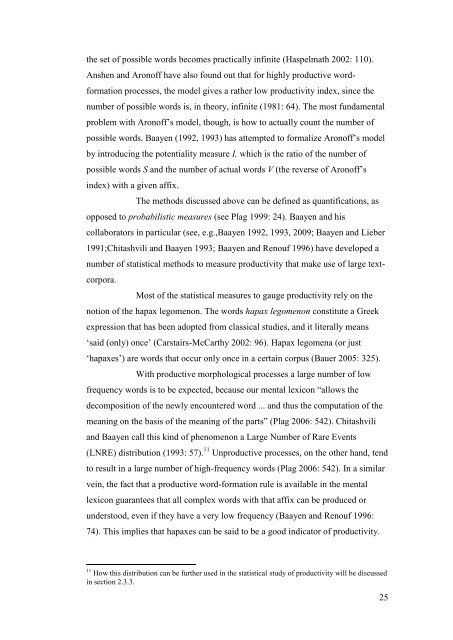The morphological productivity of selected ... - Helda - Helsinki.fi
The morphological productivity of selected ... - Helda - Helsinki.fi
The morphological productivity of selected ... - Helda - Helsinki.fi
You also want an ePaper? Increase the reach of your titles
YUMPU automatically turns print PDFs into web optimized ePapers that Google loves.
the set <strong>of</strong> possible words becomes practically in<strong>fi</strong>nite (Haspelmath 2002: 110).<br />
Anshen and Aron<strong>of</strong>f have also found out that for highly productive wordformation<br />
processes, the model gives a rather low <strong>productivity</strong> index, since the<br />
number <strong>of</strong> possible words is, in theory, in<strong>fi</strong>nite (1981: 64). <strong>The</strong> most fundamental<br />
problem with Aron<strong>of</strong>f’s model, though, is how to actually count the number <strong>of</strong><br />
possible words. Baayen (1992, 1993) has attempted to formalize Aron<strong>of</strong>f’s model<br />
by introducing the potentiality measure I, which is the ratio <strong>of</strong> the number <strong>of</strong><br />
possible words S and the number <strong>of</strong> actual words V (the reverse <strong>of</strong> Aron<strong>of</strong>f’s<br />
index) with a given af<strong>fi</strong>x.<br />
<strong>The</strong> methods discussed above can be de<strong>fi</strong>ned as quanti<strong>fi</strong>cations, as<br />
opposed to probabilistic measures (see Plag 1999: 24). Baayen and his<br />
collaborators in particular (see, e.g.,Baayen 1992, 1993, 2009; Baayen and Lieber<br />
1991;Chitashvili and Baayen 1993; Baayen and Renouf 1996) have developed a<br />
number <strong>of</strong> statistical methods to measure <strong>productivity</strong> that make use <strong>of</strong> large textcorpora.<br />
Most <strong>of</strong> the statistical measures to gauge <strong>productivity</strong> rely on the<br />
notion <strong>of</strong> the hapax legomenon. <strong>The</strong> words hapax legomenon constitute a Greek<br />
expression that has been adopted from classical studies, and it literally means<br />
‘said (only) once’ (Carstairs-McCarthy 2002: 96). Hapax legomena (or just<br />
‘hapaxes’) are words that occur only once in a certain corpus (Bauer 2005: 325).<br />
With productive <strong>morphological</strong> processes a large number <strong>of</strong> low<br />
frequency words is to be expected, because our mental lexicon “allows the<br />
decomposition <strong>of</strong> the newly encountered word ... and thus the computation <strong>of</strong> the<br />
meaning on the basis <strong>of</strong> the meaning <strong>of</strong> the parts” (Plag 2006: 542). Chitashvili<br />
and Baayen call this kind <strong>of</strong> phenomenon a Large Number <strong>of</strong> Rare Events<br />
(LNRE) distribution (1993: 57). 11 Unproductive processes, on the other hand, tend<br />
to result in a large number <strong>of</strong> high-frequency words (Plag 2006: 542). In a similar<br />
vein, the fact that a productive word-formation rule is available in the mental<br />
lexicon guarantees that all complex words with that af<strong>fi</strong>x can be produced or<br />
understood, even if they have a very low frequency (Baayen and Renouf 1996:<br />
74). This implies that hapaxes can be said to be a good indicator <strong>of</strong> <strong>productivity</strong>.<br />
11 How this distribution can be further used in the statistical study <strong>of</strong> <strong>productivity</strong> will be discussed<br />
in section 2.3.3.<br />
25
















